Look up! There are lots of hawks in Southern California, and spotting one is always a thrill. If you have recently seen a magnificent bird of prey soaring above you and wondered what it was, I am here to help!
I have been a huge fan of identifying birds of prey ever since I took a class on Captive Raptor Management at UC Davis many moons ago. These special birds are truly wonderous to watch, and an important part of our ecosystem.
Here are eight hawks in Southern California that you might spy when hiking, camping, or simply walking your neihgborhood. I have also included lots of pictures and distinguishing characteristics to help you identify these incredible birds.
Here is our full guide to all 34 California birds of prey.
8 Hawks in Southern California and How to Identify Them
1. Red-Tailed Hawk
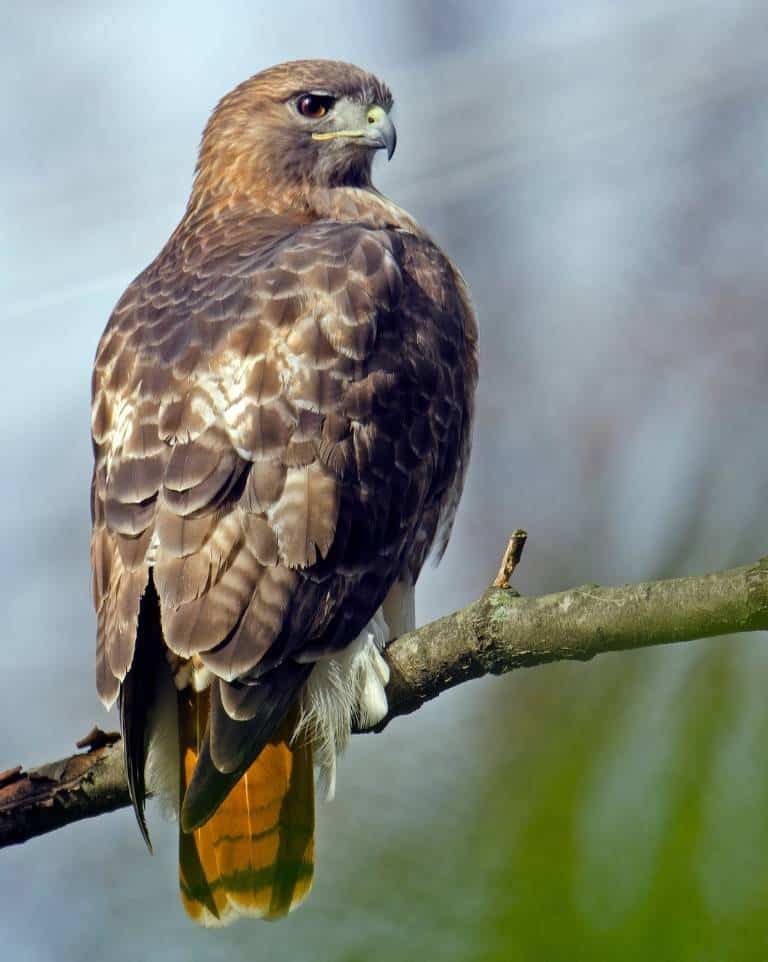
Quick ID Summary: A large, broad-winged raptor (18–26 inches long, 3.5–4.8 ft wingspan). Adults are brown above and pale below with a streaked belly band and a distinctive brick-red tail. Their scream is iconic in films and sometimes used as a replacement other bird’s true calls.
Juvenile Plumage Notes:
Juveniles lack the red tail, instead displaying brown, barred tails and more streaking overall. Their plumage is more mottled and may resemble a Rough-legged Hawk, though bulkier.
One of the most common hawks in Southern California is the Red-tailed Hawk. It is also one of the easiest birds of prey to identify thanks to its signature red tail.
Habitat & Distribution: Widespread across Southern California. Found in deserts, mountains, grasslands, agricultural fields, and even urban parks. One of the most commonly seen hawks year-round.
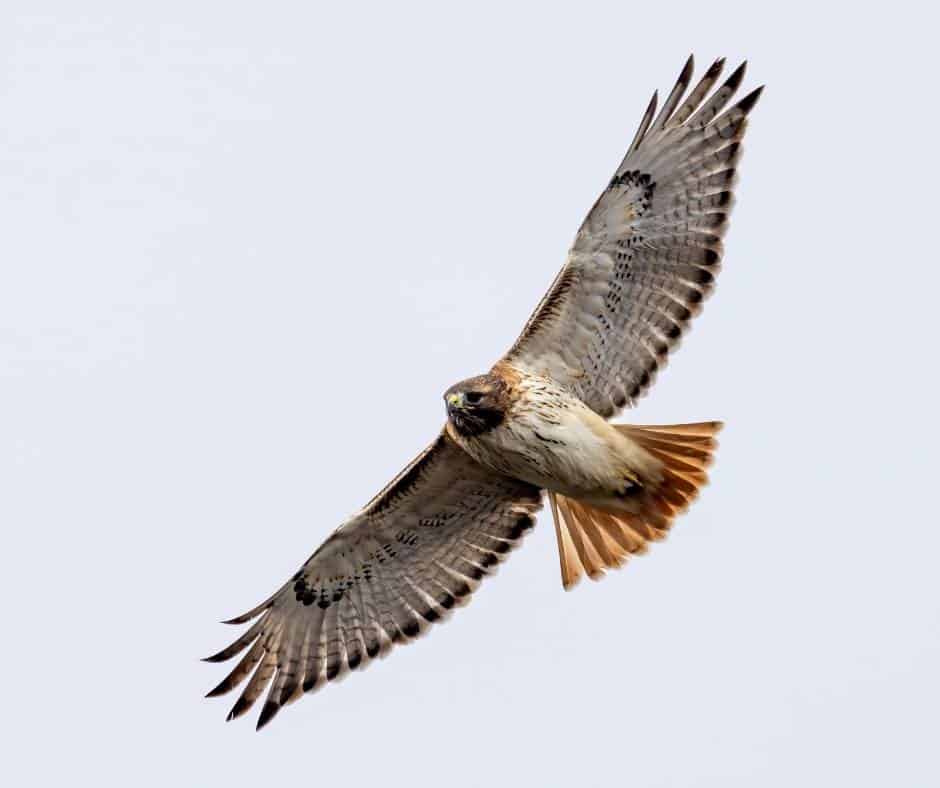
Behavior Highlights: Often seen soaring in circles or perched on telephone poles and fence posts. Hunts a wide variety of rodents, rabbits, lizards, snakes, insects, and even fish! Monogamous and nests in tall trees, cliffs, or man-made structures.
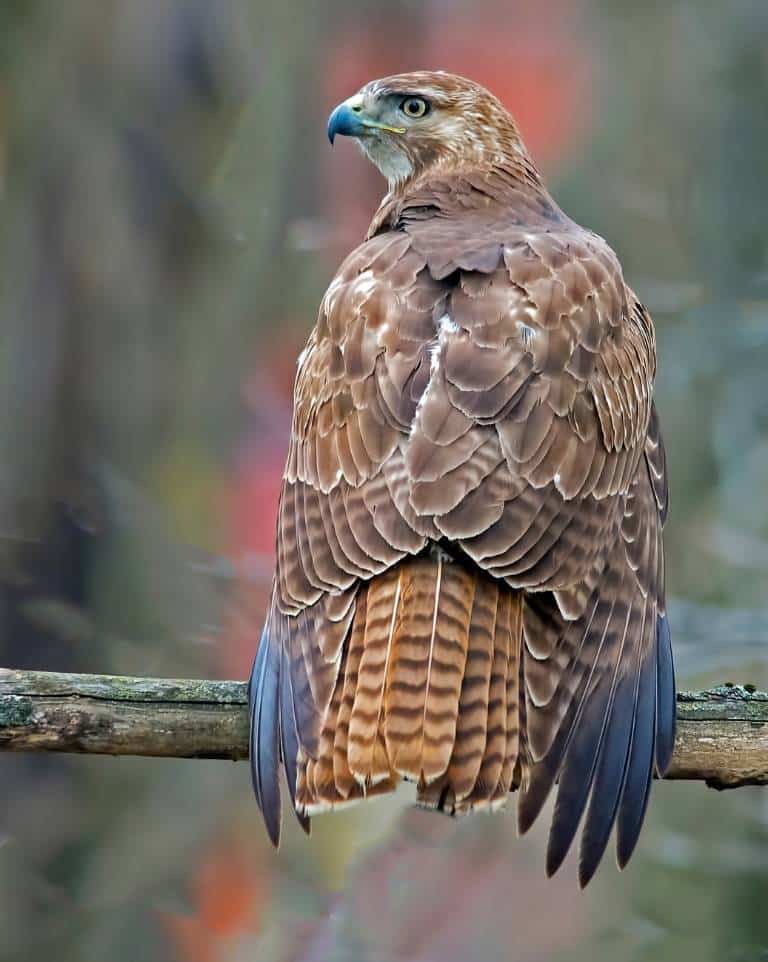
Juvenile Notes: There is an exception to the “red tail rule”. Juveniles have lighter chests and their tails have evenly spaced brown and white bars on them. They generally lose their banded (or striped) tails when they are about 18 months old.
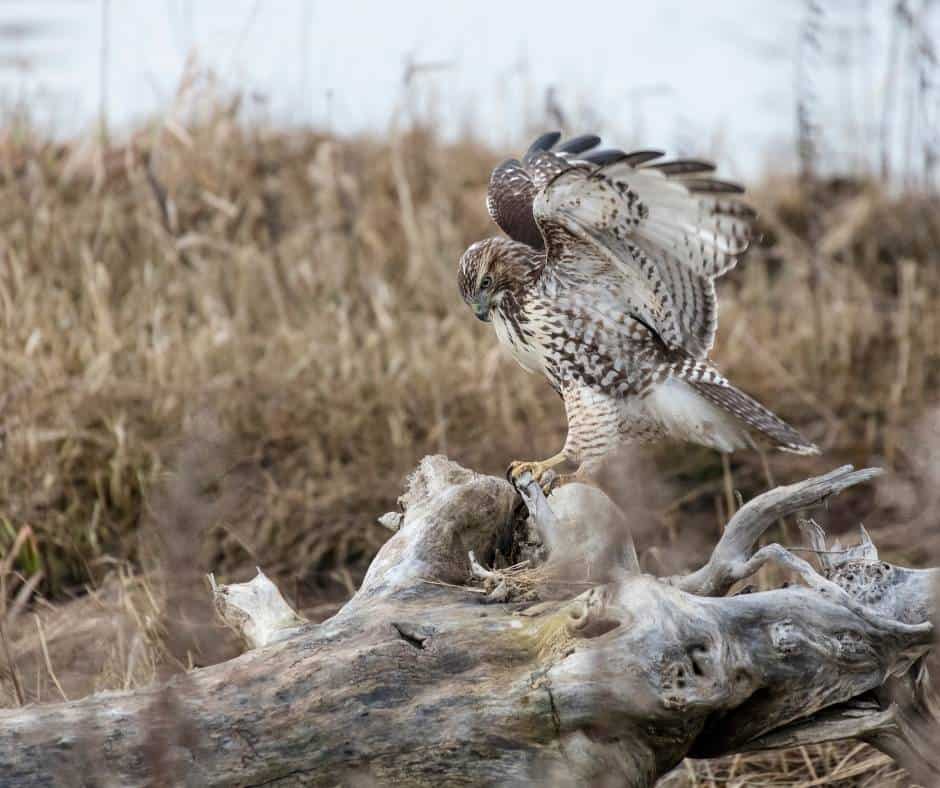
Red tailed-Hawks are excellent co-parents and work together to build their nest, incubate the eggs, and raise their young. Red-tailed hawks tend to lay 2-3 white eggs with brown spots at a time.
Young Red-tailed Hawks stay with their parents for about 10-12 weeks and generally fledge (begin to fly) around 45 days.
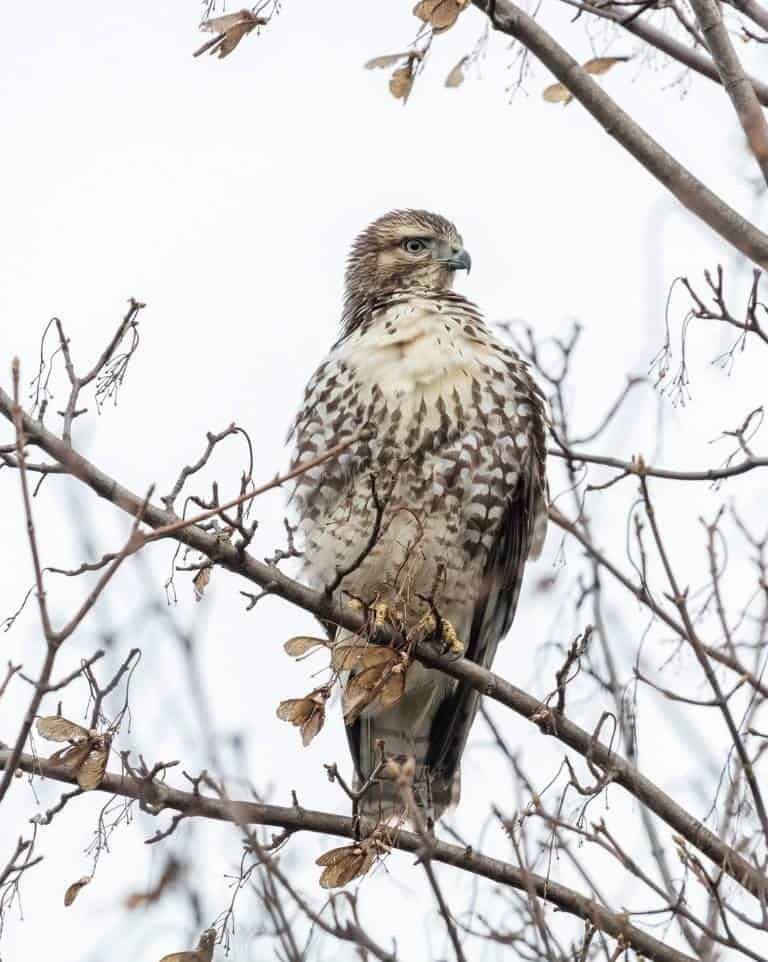
Red-tailed Hawks have distinctive screeches that will help you identify them as well. You can hear them here.
2. Ferruginous Hawk

Quick ID Summary: The largest hawk in North America (22–27 inches long, 4.5–5.7 ft wingspan). Adults have pale heads, rust-colored backs and legs, and white underparts with variable markings. Light morphs dominate, but dark morphs exist and are chocolate-brown overall. Their calls are high-pitched and whining.
Far less common than the Red-tailed Hawk, the Ferruginous Hawk does use Southern California as a wintering destination.
Habitat & Distribution: Prefers open country like grasslands, deserts, and sagebrush flats. Most commonly found in southeastern California, especially the Imperial and Antelope Valleys, during winter migration.
This species is considered to be “threatened” due to habitat loss and hunting.
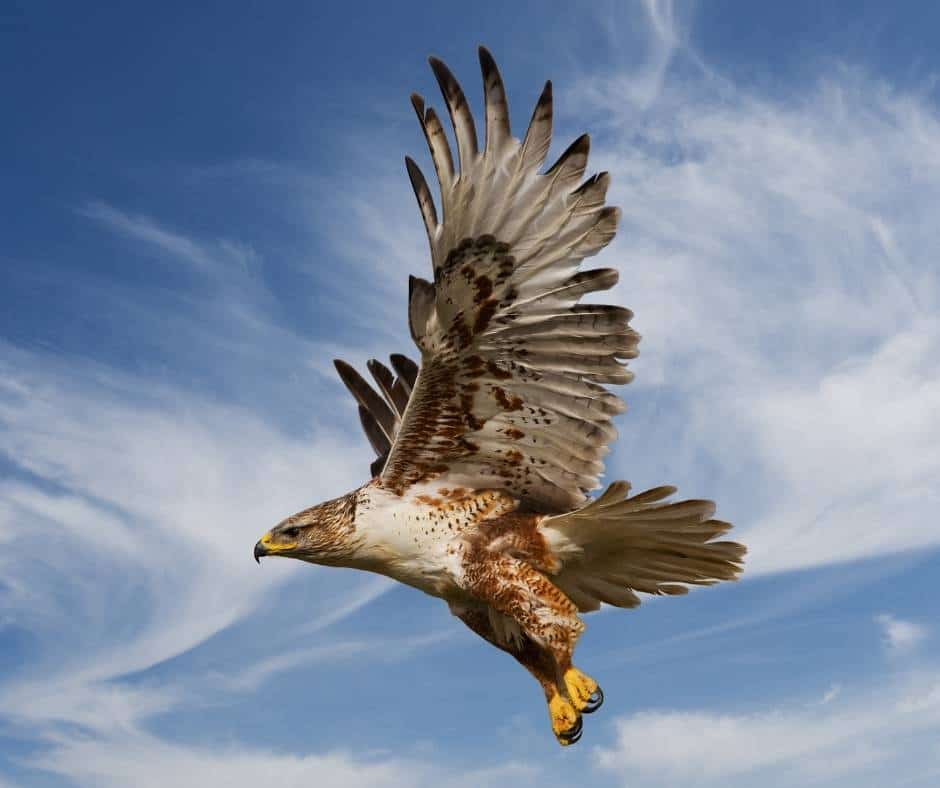
Behavior Highlights: Hunts primarily from the ground or low perches, favoring prairie dogs, ground squirrels, and rabbits. They will also eat birds and snakes.. Known for building large stick nests on cliffs, trees, or utility poles. Generally avoids forested or heavily urban areas.
They may start with an old nest, like a crow’s nest, and then make it much bigger and bulkier with lots of sticks and twigs, as well as cow dung. They often return to their nests year after year, growing them to huge sizes over time.
Back when bison roamed the West, Ferruginous Hawk’s built their nests with sticks and pieces of bison bones, and lined their nests with bison dung!

These hawk can be identified in flight by the V that forms as result of their rust legs and white underparts.
Juvenile Plumage Notes: Juveniles will have some brown spotting on their legs and stomach. Their is a darker morph version of the Ferruginous Hawk which is chocolate in color, but it is very rare.
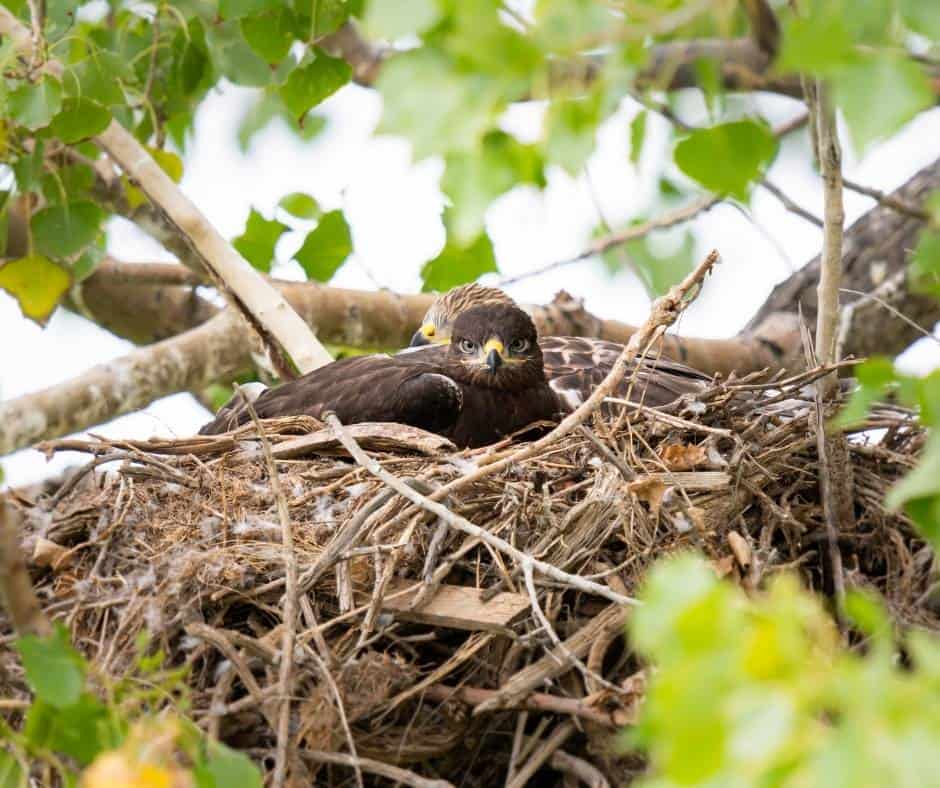
Ferruginous Hawks co-parent as well, but the mother does most of the nesting and the father does the bulk of the hunting.
When the chicks hatch (typically 2-4), the mother stays with them for the first three weeks. Father brings back food, mother feeds it to the chicks. Eventually, around thee weeks, both parents start hunting. The chicks fledge at 45 days and stay a few weeks longer after that to learn to hunt with their parents.
Listen to the sounds of a Ferruginous Hawk.
3. Red-Shouldered Hawk

Quick ID Summary: Medium-sized hawk (16–24 inches long, 3–4 ft wingspan). Adults have striking reddish-brown underparts, black-and-white banded wings, and a black tail with narrow white bands. Their loud, repetitive “kee-ahh” call is often heard before the bird is seen.
The Red-shouldered Hawk is onother one of the most commonly spotted hawks in Southern California. This beautiful bird has a year-round population in Southern California.
Habitat & Distribution: Common in riparian woodlands, oak forests, and suburban areas with tall trees (like eucalyptus and oak) and nearby water. Found year-round across coastal Southern California, especially in Los Angeles, Orange, and San Diego Counties.
It also makes an appearance in residential areas when there is bird feeder attracting song birds that it can easily hunt and eat.
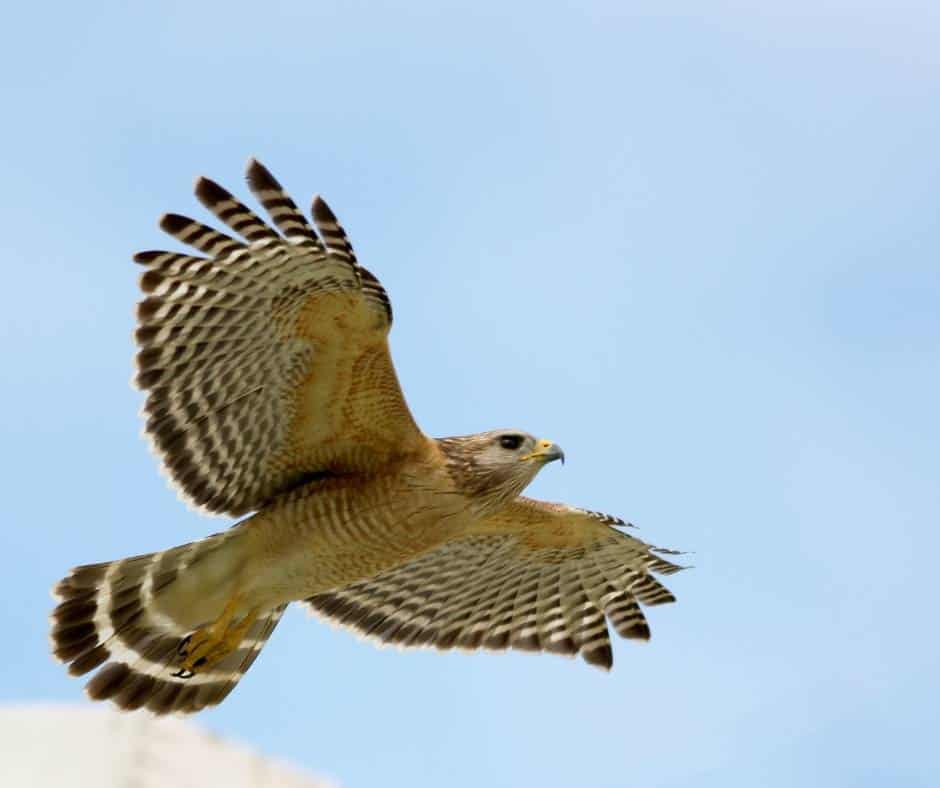
Behavior Highlights: Often seen perched on utility poles or gliding through wooded neighborhoods. Hunts small mammals, reptiles, and amphibians. Can be quite vocal during nesting season.
These hawks do return to the same nest year after year, so once you have found their “spot”, you can expect to see your new pals again next year. Their nests usually have 3-4 pale eggs that are blotched with brown and lavender.
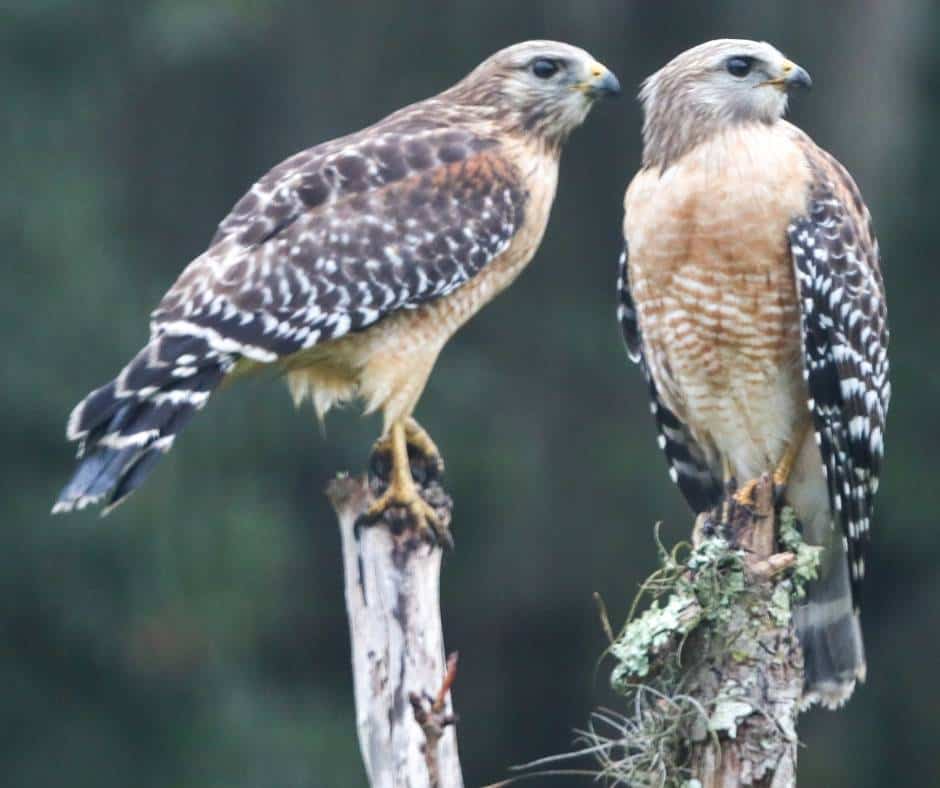
Females tend to do the bulk of the nest incubating and watching while males do the bulk of the hunting. Young Red-shouldered Hawks fledge after about six weeks, but hang out with their parents for another 8-10 weeks to get fed and learn how to hunt.
Listen to the calls of the Red-shouldered Hawk.
Explore Southern California with these 20 incredible weekend getaways.
4. Cooper’s Hawk

Quick ID Summary: Medium-sized hawk (14–20 inches long, ~2.5–3 ft wingspan) with a rounded tail and short, broad wings. Adults have steely blue-gray upperparts, reddish-barred underparts, and a dark cap. Their call is a rapid “cak-cak-cak” often heard near nests.
Habitat & Distribution: Thrives in mixed forests, suburbs, and city parks. Common year-round throughout Southern California, especially in urban neighborhoods with bird feeders.
If you have a bird feeder, there is a chance that a Cooper’s Hawk might look at it as a smorgasbord, and we aren’t taking about the bird seed! If you do have a hawk that is suddenly using your bird feeder as a hunting ground, remove it for a week and the bird will move on.
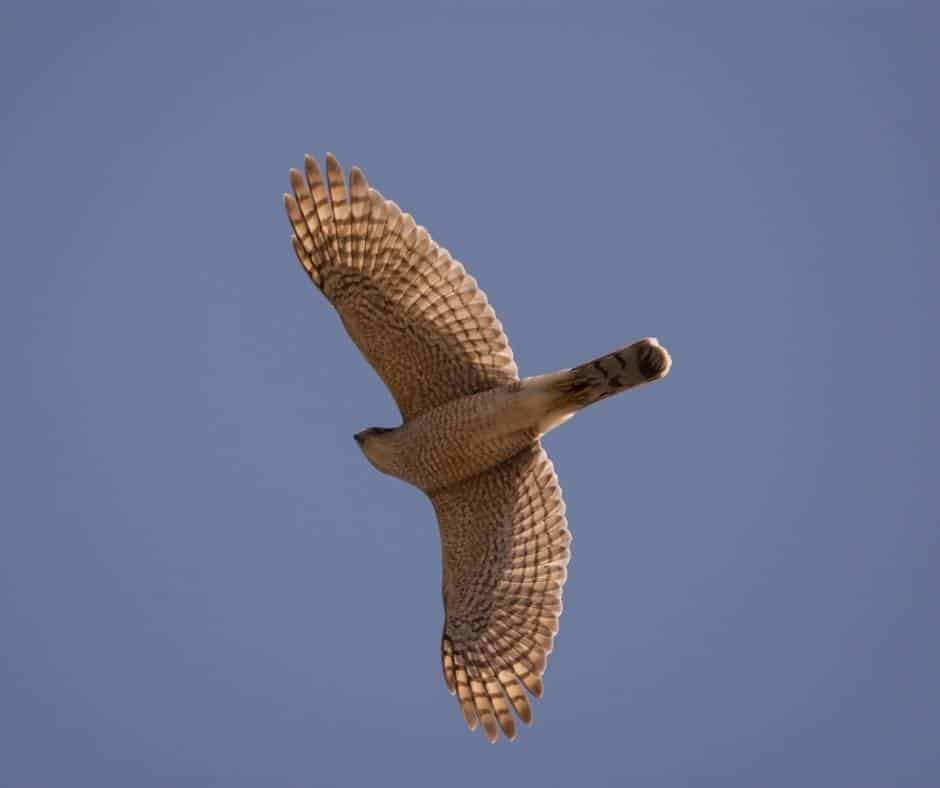
Behavior Highlights: An agile flier that darts through trees when hunting. Specializes in catching songbirds and kill their prey by squeezing it to death, but they have also been known to drown their prey as well.. Cooper’s Hawks are increasingly urbanized and tolerate human presence.
One of the more gruesome facts about Cooper’s Hawks revolves around the fact that it likes to eat medium-sized birds, including their own!
A male Cooper’s hawk is much smaller than a female (they are both around crow size. Males are a small crow, females are a large crow), so it has to be very submissive to the female and send out calls letting her know it is a mate and not food.
Then, the male considers the submission (any thing to make you happy honey, just don’t eat me!) by building the nest and providing all the food for its mate and their young for three months until the young leave the nest.
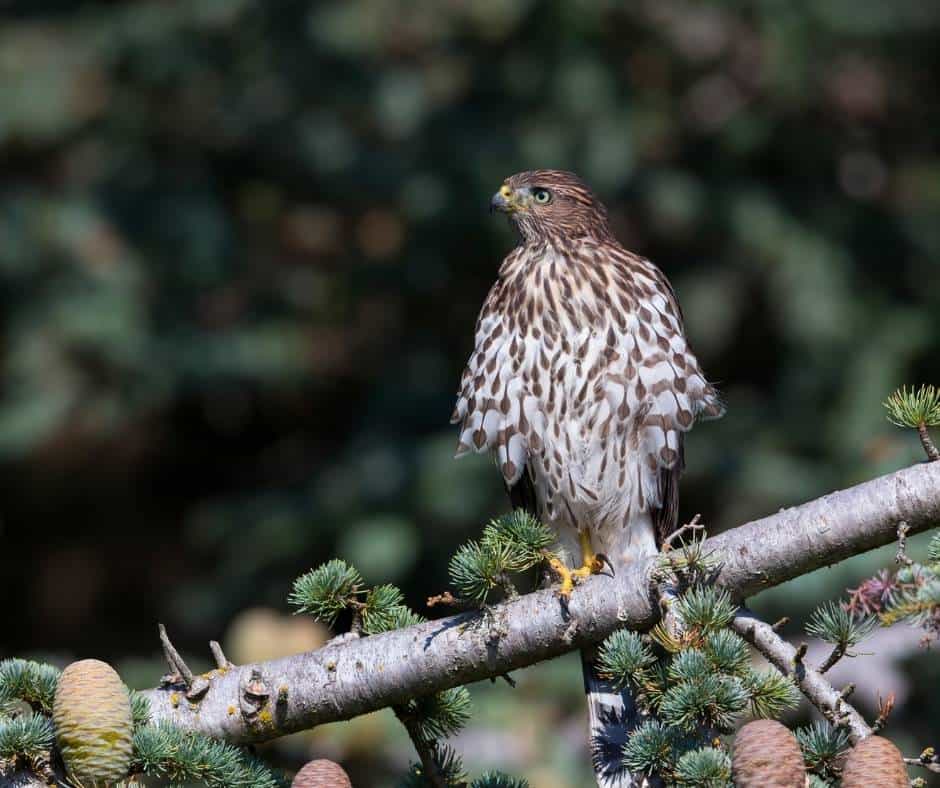
Juvenile Plumage Notes: Juveniles have brown and white streaking on their chests (instead of the red) and their eyes are more yellow.
Cooper’s Hawks look very similar to the next hawk on our list, the Sharp-shinned Hawk and it can be tricky to tell them apart. Keep reading to learn more about how to tell who’s who!
Listen to the sounds that a Cooper’s Hawk makes.
5. Sharp-shinned Hawk

Quick ID Summary: It is the smallest hawk in North America (9–13 inches long, ~17–22 inch wingspan). Compact body with short, rounded wings and a squared-off tail. Adults have slate-gray backs and finely barred reddish-orange chests. Their call is a rapid, high-pitched “kik-kik-kik.”
Sharp-shinned Hawks look, and in many ways behave, like Cooper’s Hawk, but they are smaller and more secretive.
Habitat & Distribution: Prefers dense forests and wooded canyons, but is seen in urban areas during migration. Winters across Southern California and is more elusive during breeding season, typically nesting at higher elevations.
Like the Cooper’s Hawk, they have also adapted to live in urban and suburban areas which are home to lots of songbirds and bird feeders.
Behavior Highlights: A swift, stealthy hunter of small birds, often ambushing them at feeders or flitting through thick trees. Unlike Cooper’s Hawks, they rarely perch in the open for long.
When the Sharp-shinned hawk catches their prey, the bang their future meal on a stump or low branch until they die. These hawks tend to eat smaller birds like robins or sparrows, but they will also eat small amphibians and mammals if available.
So how does one tell a Cooper’s Hawk from a Sharp-shinned Hawk? They both have bluish-gray backs, reddish chests, reddish-gold eyes and a blackish-gray cap on their heads. They both have long, banded tails. Even the juveniles have similar indentifiers!
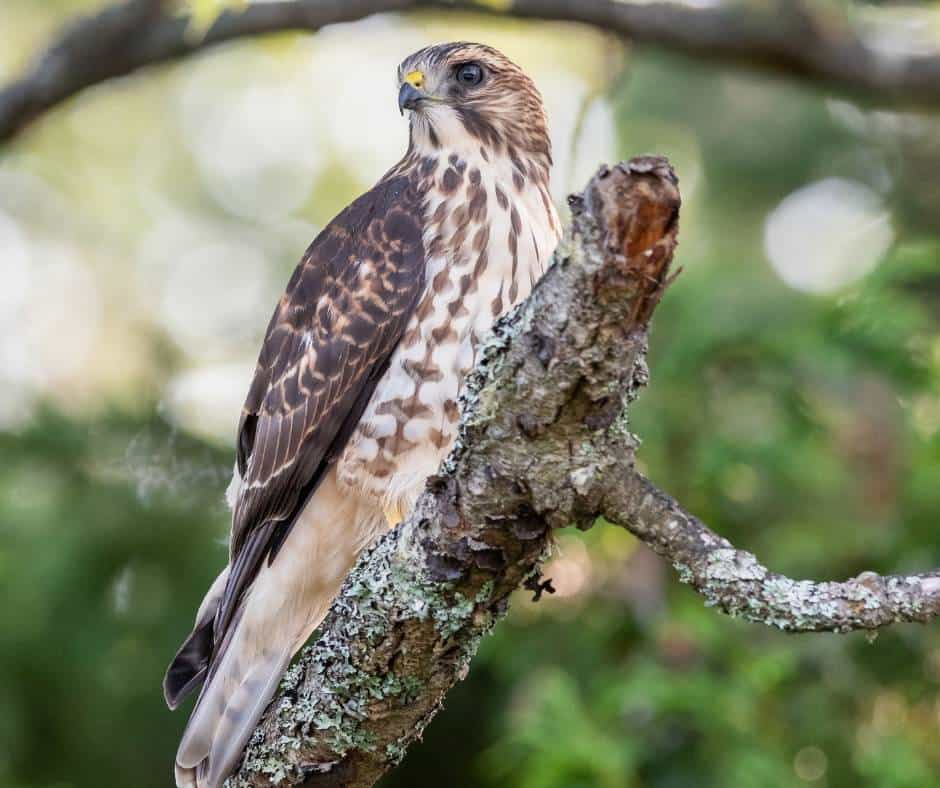
Well, when they are in flight, it can be very difficult to tell these two hawks apart. Sharp-shinned Hawks are smaller than Cooper’s Hawks but perspective is hard to gain when they are midair. The best identifier is that Sharp-shinned Hawks have square-edged tails while Cooper’s Hawks have rounded tails.
Juvenile Plumage Notes: Juveniles are brown above with streaked underparts and a thin white eyebrow. Their tails are squared and have narrow dark bands, helping distinguish them from Cooper’s Hawks.
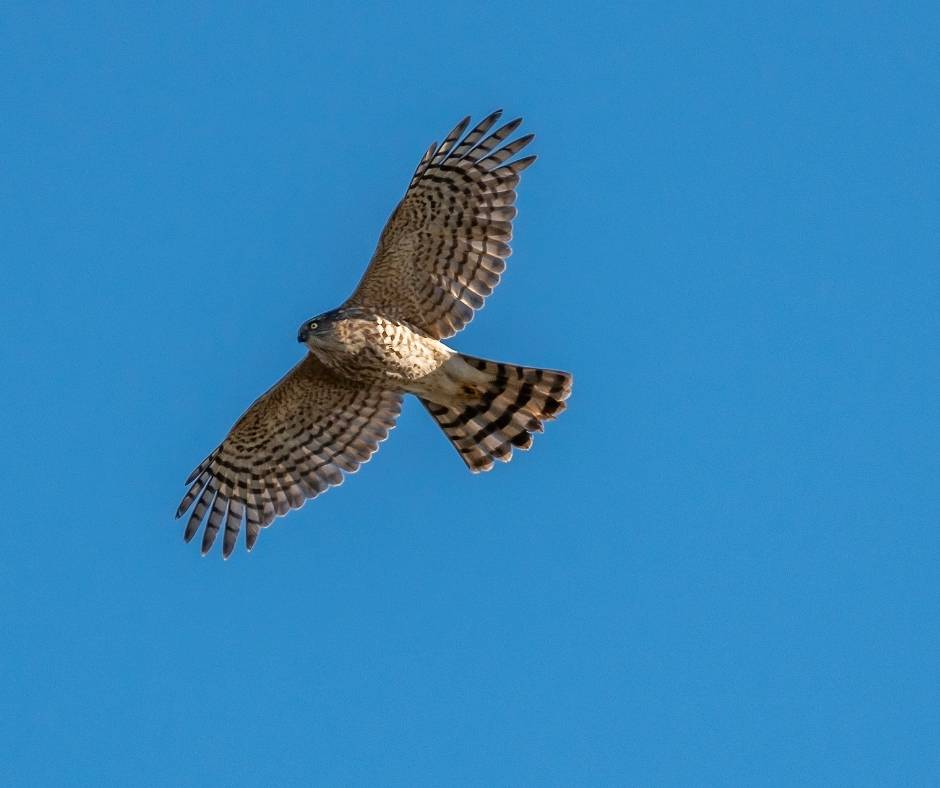
If you can see a the hawk perched, take a look at its head. The Sharp-shinned Hawk has a curved head and short neck. The Cooper’s Hawk has a flat head and slightly longer neck.

These are the sounds that a Sharp-shinned Hawk makes.
6. Northern Goshawk
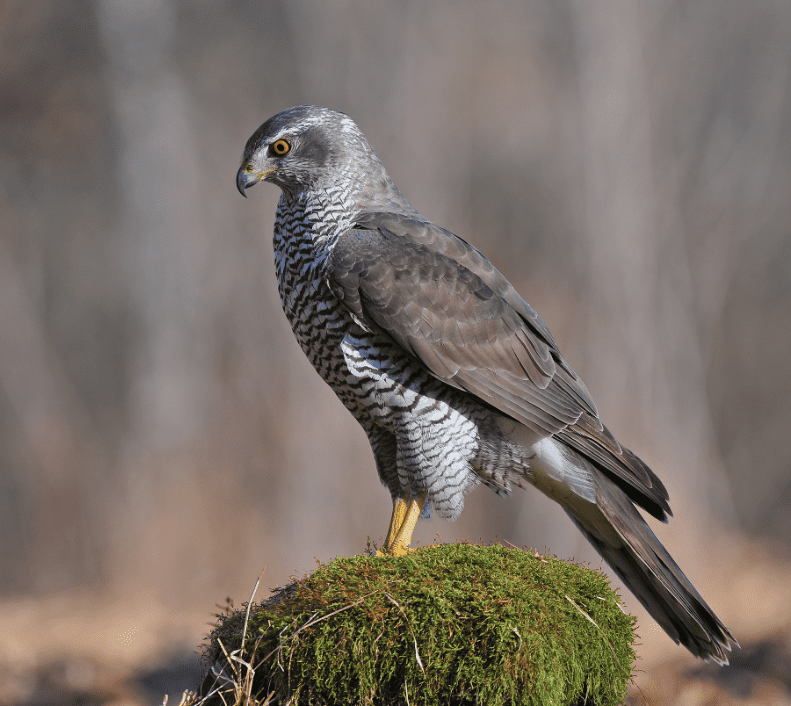
Quick ID Summary: Large, powerful bird of prey (21–26 inches long, ~40–46 inch wingspan). Adults are slate-gray with a bold white eyebrow and finely barred underparts. Their deep “kak-kak-kak” alarm call is often heard during breeding season.
Habitat & Distribution: Rare in Southern California because they prefer mature coniferous or mixed forests at higher elevations. Can be found in the San Gabriel, San Bernardino, and Sierra Nevada mountains during winter or migration. Look for them around Mt. Pinos and Frazier Mountain near the I-5 Grapevine.

Behavior Highlights: Northern Goshawks are sit-and-wait predators. They will sit on a treetop and patiently wait until they spot prey like squirrels, woodpeckers, rabbits, or even small birds of prey. The do breed in monogamous pairs and have huge territorys of 2,000-8,000 acres. There are about 1,000 breeding pairs in the state.

Juvenile Plumage Notes: Juveniles are brown above with bold streaking below and a faint white eyebrow. They often appear bulkier and darker than juvenile Cooper’s Hawks or Sharp-shinned Hawks.

Here are the sounds that a Northern Goshawk makes.
7. Northern Harrier
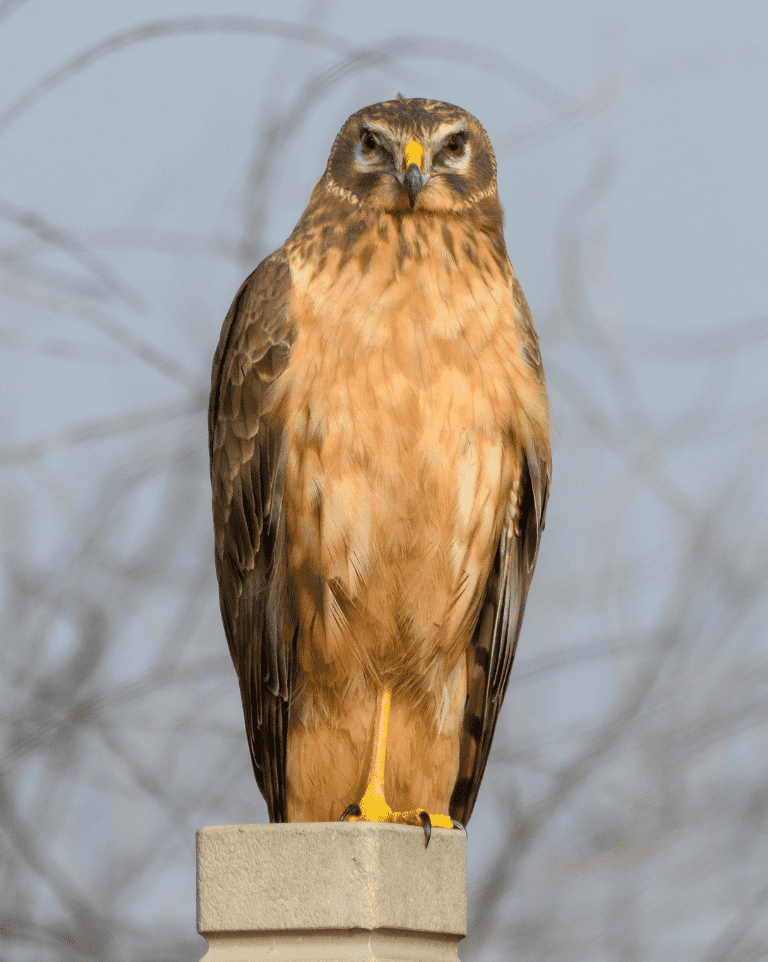
Quick ID Summary: Medium-sized raptor (18–20 inches long, ~40–46 inch wingspan). Slim body, long tail, and distinct white rump patch. Males are pale gray above; females and juveniles are brown. Known for their owl-like facial disk and low, gliding flight.
Northern Harriers are spotted in Southern California in the winter, mainly over grasslands and marshes. This is a non-breeding population of hawks; they use Southern California as a wintering location before heading back north to the Pacific Northwest.
Habitat & Distribution: You are far more likely to see this bird in the rice fields or salt water marshes of Central and Northern California, but they have been spotted in marshy areas like the Newport Beach Back Bay, especially during the winter.
These birds are small and light, but their long wings and tails make them appear larger, around the size of a crow. As with nearly all hawks, the females are significantly larger than the males.
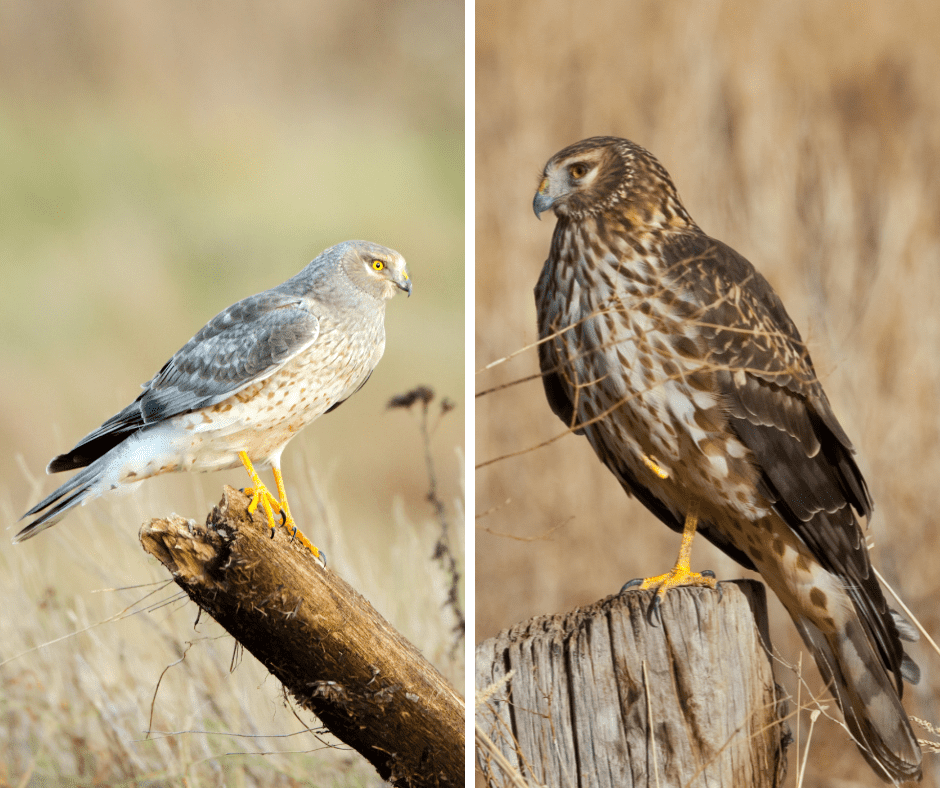
Females are different colors than the males. Males are gray on top and white underneath. They have black wing tips. Females are dark brown on top and have light brown streaky underparts. Both have a white patch near their rump which is a main identifier of this hawk in flight.
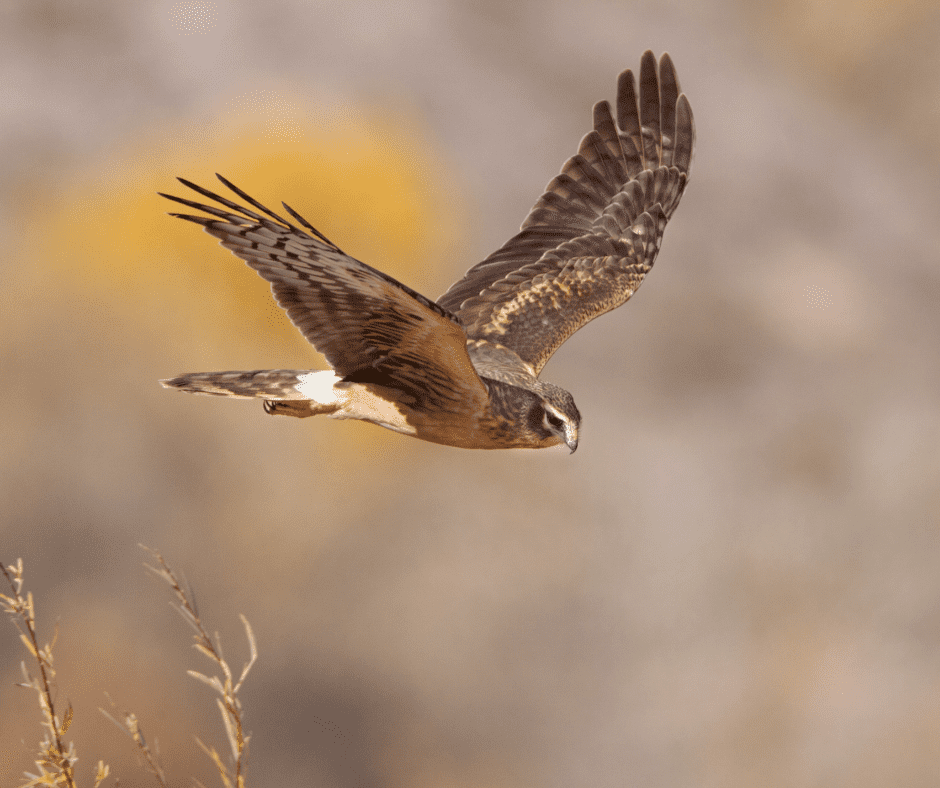
Behavior Highlights: Northern Harriers fly in a v-shape, with their wings higher than their bodies. They also hunt by sound and have a heart-shape facial disk that helps them locate their prey, just like owls. They mainly eat small mammals and birds that live in the marshy areas like mice, voles, and even small ducks. They build their nests on the ground in dense vegetation.
Juvenile Plumage Notes: Juveniles resemble adult females but are richer reddish-brown below and have less distinct facial markings. Their white rump patch remains a key field mark.
Listen to the high-pitched calls of the Northern Harrier.
8. White-Tailed Kite
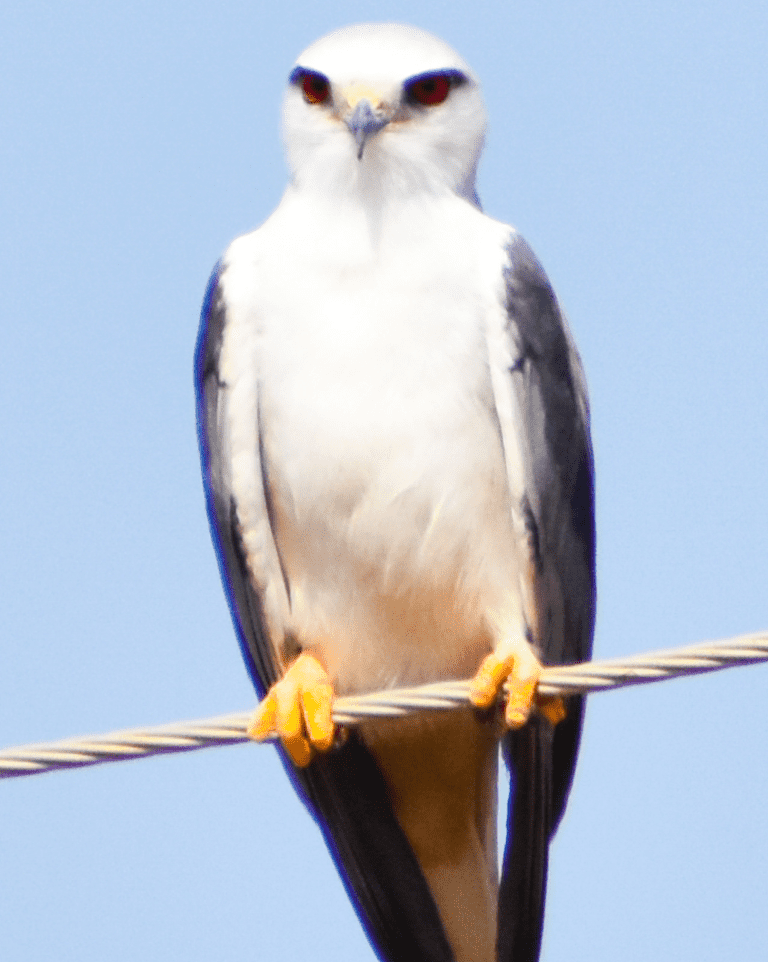
Quick ID Summary: Small, sleek raptor (~14–17 inches long, ~35–40 inch wingspan) with white underparts, face, and tail; gray upperparts and black patches on the shoulders. Notable for its graceful flight and ability to hover in place.
White-tailed Kites are some of the smallest hawks you will see in Southern California. They are typically crow-sized. The largest population of White-tailed Kites in North America is found in California, mainly in the grassy lowlands west of the desert.
Habitat & Distribution: They like farmland, wetlands, and open grasslands. They will roost in trees on the edges of these more open areas. When they aren’t breeding, you can often find White-tailed Kites roosting together in great numbers, sometimes up to 100 birds will hang out together in a small cluster of trees! Often seen in Orange County and North San Diego County.
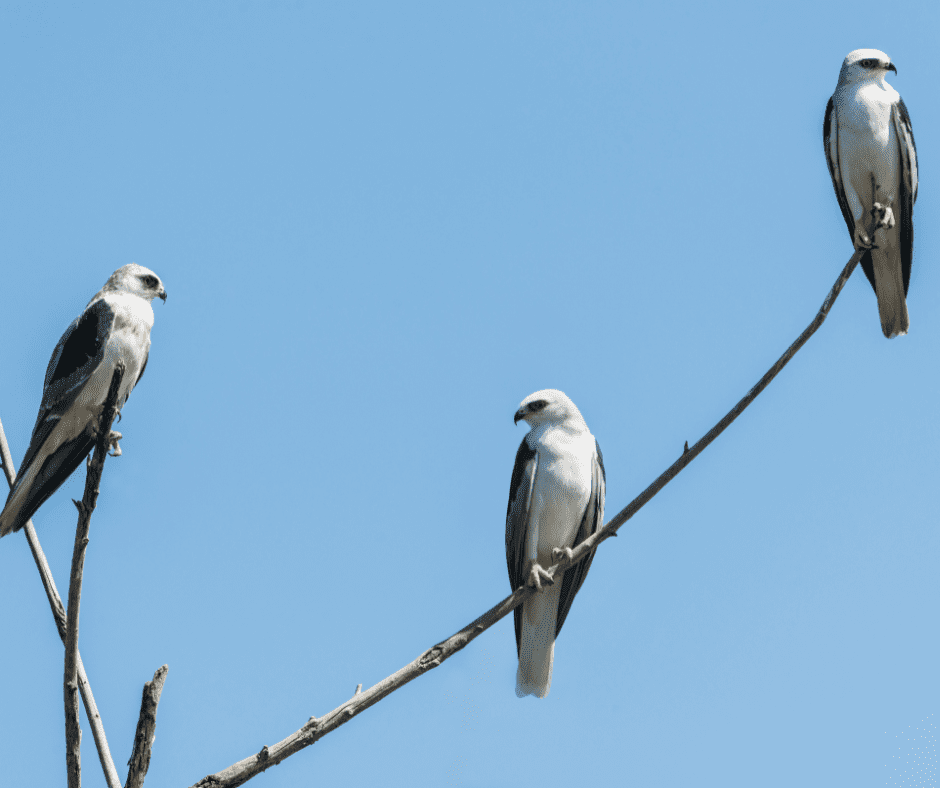
Behavior Highlights: This bird eats mostly mice and voles, and hunts by hovering above the ground with its wings flapping and its head tipped down. This behavior is called “kiting”. When it sees movement of a mouse or vole on the ground, it then darts down to grab it.
White-tailed kites are usually fairly easy to identify thanks to their distinct coloring. They have white tails (it’s not just a clever name!), white heads, gray bodies, white underparts, and black shoulder patches. Eyes are generally orange or red.
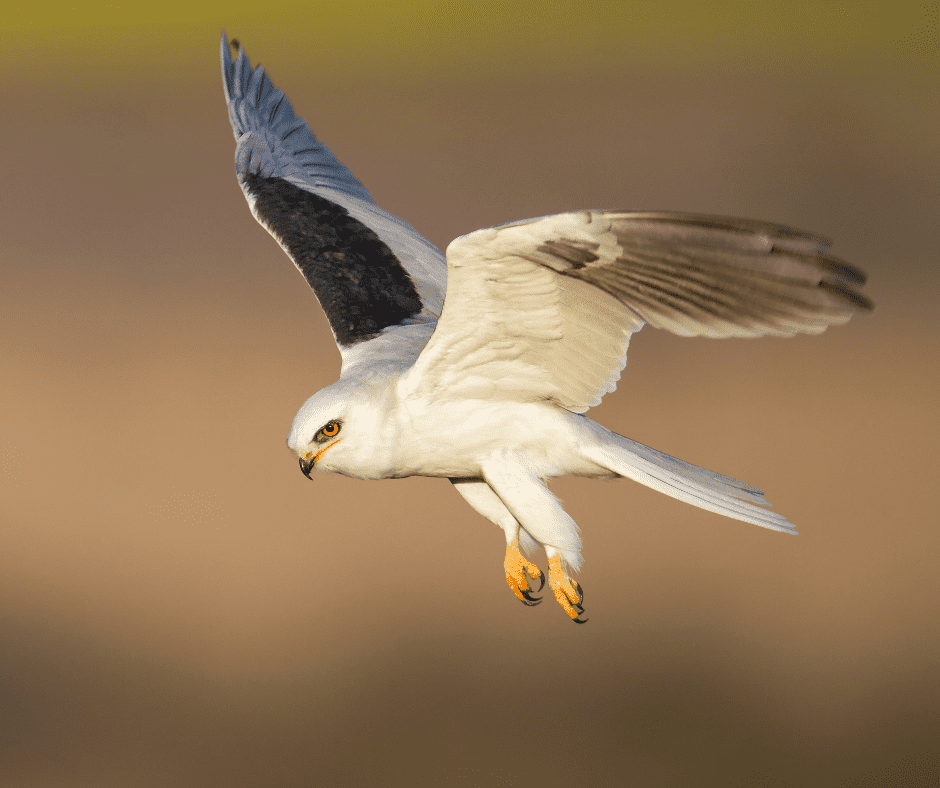
Females lay about four eggs at a time which are creamy white with some brown. The female incubates the eggs and stays with them until they are ready to fly. Males hunt and bring food. Young White-tailed Kites begin to fly after about a month and will return to the nest for a coupel more weeks to be fed and to sleep.
Listen to the calls of a White-tailed Kite.
🦅 FAQ: Hawks in Southern California
What is the most common hawk in Southern California?
The Red-tailed Hawk is the most commonly seen hawk in Southern California. It adapts well to both urban and rural areas and is often spotted soaring over highways, fields, and hillsides.
How can you tell a hawk from other birds of prey?
Hawks typically have broad wings, short hooked beaks, and keen eyesight. They differ from falcons by their slower wingbeats and gliding flight, and from eagles by their smaller size and more varied habitats.
Do hawks live in cities?
Yes, many hawks like Cooper’s Hawks and Red-shouldered Hawks thrive in urban and suburban environments, nesting in city parks, backyards, and near golf courses where prey like rodents and small birds are plentiful.
Are hawks dangerous to pets?
Hawks may pose a risk to very small pets (under 5 pounds), especially puppies, kittens, or small outdoor animals. However, attacks are rare and most hawks prefer wild prey like rodents and birds.
When is the best time to see hawks in Southern California?
Hawks can be seen year-round, but fall and winter are excellent times due to seasonal migrations. During these months, both resident and migratory hawks may be spotted more frequently in open spaces.
Do hawks migrate through Southern California?
Yes, species like the Ferruginous Hawk and Northern Harrier migrate through Southern California, especially during fall and winter months. Look for them in grasslands, wetlands, and agricultural areas.
What should I do if I see an injured hawk?
Contact a licensed wildlife rehabilitation center or local animal control. Do not attempt to handle the hawk yourself—raptors have sharp talons and strong beaks that can injure people.

